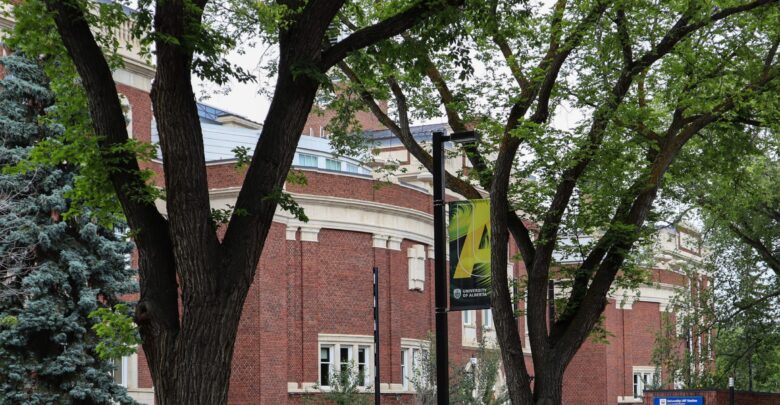 Leah Hennig
Leah HennigI’ll fully admit that if someone told me that I was the best at something, it’d probably go to my head. But the University of Alberta should be able to recognize that there’s more important things than titles and prestige.
The U of A puts so much time and effort towards trying to climb higher in national and international university rankings. This might seem fine or maybe even great on the surface, but it comes at the expense of students. While the U of A is busy trying to climb up in global rankings, tuition is going up and the quality of education isn’t necessarily matching the cost.
The U of A’s strategic plan, SHAPE, will guide the next ten years of our university. But the plan itself focuses on rankings and benchmarks from outside of the university. The university has lost sight of the student experience. Most of the targets are either rankings, amounts of revenue, or standards determined by U15, an association of fifteen Canadian research universities. If the U of A wants to make meaningful improvements, it needs to pay attention to its students. Not rankings and numbers that barely take students into consideration, if at all.
The rankings don’t hold much meaning to the average student. Most of the cited and celebrated rankings from organizations like Times Higher Education (THE) focus on research and industry presence. Whether the U of A is highly-rated in research quality, industry, or international outlook is largely inconsequential to the student experience. Yet the university talks about these rankings like they also equate to a quality education and experience.
According to THE’s international ranking of the U of A, its 2024 international outlook is quite high, at 90.7 out of 100. This might help attract international students under the impression that their experience will be of that quality. But the reality can be quite different. Not only is international student tuition much higher than domestic tuition at the U of A. Current international students face even more challenges outside of tuition costs.
That 90.7 doesn’t mean that it’s a great place for international students to learn. It means that there’s a good ratio of international students to domestic students, international staff to domestic staff, and international collaboration. Recently, the U of A created a new administrative role, vice-president (international and enterprise), that largely focuses on increasing international student growth. The role doesn’t really consider international students currently on our campus. It’s about the numbers and rankings.
When you look at THE’s ranking of teaching, it’s disappointing to say the least. A solid 50.1 is all the U of A achieved in 2024 for its teaching, which is marginally higher than previous years. This is the first time in eight years that it’s been above 50. For most students, 50.1 would be a bare pass and probably enough to get them to study harder for the next exam. But if the small changes in this rating show anything, it’s that improving teaching quality is not a priority.
Beyond the global rankings, THE also ranks universities for their impact on the United Nations Sustainable Development Goals (SGD). For 2024, the U of A ranked sixth overall, and fourth for zero hunger, which sounds great. This ranking evaluates a university’s efforts in “pioneering world hunger solutions,” as well as research and initiatives dedicated to food security. But once again, these rankings are meaningless to students who are just trying to get by while they’re in school. Fourth for zero hunger isn’t impressive to a student body that’s seen increased usage at the Campus Food Bank year after year. But the U of A prioritizes these rankings over making improvements that actually impact its students.
One of the few ranking organizations that considers students is Maclean’s student services rankings. Per usual, there’s not much consideration for impact on students. The determining factor is per cent of funding that goes towards student supports. Out of the medical doctorate universities in Canada, the U of A falls dead last. According to Maclean’s, only 2.7 per cent of the U of A’s budget goes towards student services. The only ranked school that puts less of its budget towards student services is Université du Québec à Montréal (UQAM). You’d think if the U of A is asking us to pay more, we would get more in return. Apparently that’s not the case.
The U of A also cites the National Survey of Student Engagement (NSSE) in SHAPE, which is an indicator of student experience — sort of. NSSE does a survey every three years and only surveys first and fourth-year students. There’s an obvious gap of students between their first and fourth year, largely because the survey heavily weighs completion. But simply completing your degree doesn’t mean it was a good experience.
The university’s strategic plan does include a benchmark for student satisfaction. However, it’s determined by how students evaluate their entire university experience. This ignores the nuances and areas of dissatisfaction for students. A person may determine their overall experience was good or great, but still found supports lacking or tuition too expensive. By focusing only on overall satisfaction, the U of A misses the important details.
The last NSSE was conducted in 2023, but to my knowledge, the data is not publicly available. Or at least, not easily accessible. While I was able to find data for the University of Calgary very easily, my search for the U of A’s results were fruitless.
Outside of academics, surveys investigating other aspects of the student experience have been conducted in the last few years. In 2023, the Government of Alberta funded a survey about sexual and gender-based violence (SGBV) at Alberta post-secondary institutions (PSIs). It found 50 per cent of students experience SGBV during their time at Alberta PSIs. This number was much higher for U of A students, at 64 per cent. Only months after that survey was released, the U of A Sexual Assault Centre (UASAC) had its services and access reduced.
In 2019, the U of A Students’ Union (UASU) found that 12.4 per cent of students are severely food insecure and 19.4 per cent are moderately food insecure. Considering more students than ever are using the CFB, we can assume that number has only increased. There’s also the Student Perspective of Teaching (SPOT) surveys that the university asks students to do at the end of every semester. Students give feedback on their courses and instructors through SPOT.
Yet the university doesn’t talk about these things in SHAPE. It looks to rankings or U15 and NSSE benchmarks instead. Surely the lived experiences of current students can be valuable in guiding institutional improvement.
If the U of A wants to improve itself, it needs to focus on the people on our campuses right now. Not the 16,000 new students it wants to bring in, and not national or international rankings. The U of A needs to start listening to students’ concerns and needs and acting on what it hears. Otherwise, the U of A will be an internationally revered school that nobody wants to attend.




